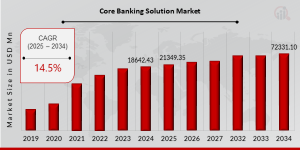Core Banking Solution Market Size, Share, Growth Trends, Key Players, Opportunities and Forecast to 2034
Core Banking Solution Market Research Report Information By, Component, Deployment, Organization Size, End User and Region
WA, UNITED STATES, August 5, 2025 /EINPresswire.com/ -- The global Core Banking Solution market has witnessed remarkable growth in recent years and is poised to expand further in the coming decade. In 2024, the market size was valued at USD 18,642.43 million and is projected to grow from USD 21,349.35 million in 2025 to an impressive USD 72,331.10 million by 2034, reflecting a robust compound annual growth rate (CAGR) of 14.5% during the forecast period (2025–2034). The growth is primarily driven by the increasing need for centralized banking operations, demand for real-time transaction processing, and improved customer experience across banking institutions.Key Drivers of Market Growth
Rising Demand for Improved Customer Experience
Modern customers expect fast, seamless, and personalized banking experiences. Core banking solutions help banks offer 24/7 access to banking services, real-time transaction updates, and integrated channels such as mobile and internet banking, significantly enhancing customer satisfaction and retention.
Need for Centralized Banking Operations
Banks are increasingly shifting toward centralized systems to streamline operations, reduce redundancies, and improve overall efficiency. Core banking solutions allow centralized control of processes like account management, payments, and compliance, enabling consistency across all branches and touchpoints.
Digital Transformation and Cloud Adoption
The banking sector is undergoing rapid digital transformation, with many institutions migrating to cloud-based core banking platforms. These solutions provide scalability, cost-efficiency, and flexibility while ensuring business continuity and faster product launches.
Regulatory Compliance and Risk Management
As regulatory environments become more complex, banks are relying on core banking systems to ensure compliance with global and local standards. These platforms help in managing risk, reporting, and data security while adhering to Know Your Customer (KYC), Anti-Money Laundering (AML), and other legal requirements.
Download Sample Pages – https://www.marketresearchfuture.com/sample_request/3208
Challenges and Restraints
High Initial Implementation Costs
One of the primary challenges in adopting core banking solutions is the high cost of implementation and system integration. Smaller financial institutions may struggle with budget constraints and resource availability, limiting their ability to adopt advanced platforms.
Legacy System Integration Issues
Many banks still operate on outdated legacy systems, making it difficult to integrate modern core banking platforms. Data migration, staff training, and operational disruptions during the transition can be major roadblocks to full-scale adoption.
Browse In-depth Market Research Report: https://www.marketresearchfuture.com/reports/core-banking-solutions-market-3208
Key Companies in the Core Banking Solution Market Include
• Temenos AG
• Oracle Corporation
• FIS (Fidelity National Information Services)
• Infosys Finacle
• SAP SE
• Tata Consultancy Services (TCS)
• Jack Henry & Associates, Inc.
• Silverlake Axis Ltd.
• Intellect Design Arena Ltd.
• HCL Technologies
• Avaloq Group AG
• Sopra Banking Software
• Finastra
• Infrasoft Technologies Ltd.
• Nucleus Software Exports Ltd., among others
Market Segmentation
To provide a comprehensive analysis, the Core Banking Solution market is segmented based on component, deployment mode, enterprise size, end-user, and region.
1. By Component
• Software: Core banking platforms for transaction management, loan processing, and customer data.
• Services: Implementation, training, support, and consulting.
2. By Deployment Mode
• On-Premise: Full control and customization; preferred by large banks with in-house IT teams.
• Cloud-Based: Increasing adoption due to lower costs, scalability, and faster updates.
3. By Enterprise Size
• Large Enterprises: High-volume transactions and advanced customization needs.
• Small and Medium Enterprises (SMEs): Growing adoption for cost-effective operations and enhanced agility.
4. By End User
• Retail Banks: Offering a wide array of personal financial services.
• Commercial Banks: Managing business accounts, loans, and high-volume payments.
• Cooperative Banks: Adopting core systems for unified operations.
• Others: Including credit unions, microfinance institutions, and digital-only banks.
5. By Region
• North America: Leading the market due to advanced infrastructure and early adoption of digital banking.
• Europe: Growth driven by regulatory reforms and increasing demand for open banking.
• Asia-Pacific: Fastest-growing region, fueled by fintech expansion, banking penetration, and mobile-first economies like India and China.
• Rest of the World (RoW): Emerging opportunities in Latin America, Africa, and the Middle East.
Procure Complete Research Report Now: https://www.marketresearchfuture.com/checkout?currency=one_user-USD&report_id=3208
The global Core Banking Solution market is on a transformative path, redefining the way financial institutions operate and serve customers. As banks continue to prioritize innovation, efficiency, and customer-centricity, the demand for agile and scalable core banking systems is expected to surge. With strong growth potential across regions and industries, the market offers lucrative opportunities for solution providers, integrators, and financial institutions aiming to future-proof their digital infrastructure.
Related Report:
Biometric Banking Market
Investment Banking Market
AllScale Partners with BNB Chain to Power Global Stablecoin Payments for Micro Businesses
AllScale joins Amber.ac's BUILD_QUESTS 2025 as an Official Partner to Support Stablecoin Innovation
Michelin-Trained Chef Reimagines Intimate Luxury Dining
Więcej ważnych informacji
 Jedynka Newserii
Jedynka Newserii

 Jedynka Newserii
Jedynka Newserii

Handel

Mercosur to tylko wierzchołek góry lodowej. UE ma ponad 40 umów handlowych, które mogą destabilizować rynek rolny
Umowa handlowa między UE a krajami Mercosur może znacząco zaburzyć konkurencję na rynku rolnym i osłabić pozycję unijnych, w tym polskich, producentów – ostrzegają rolnicy i producenci żywności. Umowie sprzeciwia się część krajów unijnych, które domagają się klauzuli ochronnych oraz limitów importowych. – Problemem jest jednak nie tylko ta konkretna umowa. Chodzi o cały system wolnego handlu, który się kumuluje z dziesiątek innych porozumień – podkreśla Andrzej Gantner, wiceprezes Polskiej Federacji Producentów Żywności.
Firma
Dzięki zdalnej weryfikacji tożsamości z wykorzystaniem AI firmy zminimalizowały liczbę oszustw. Rozwiązania wykorzystuje głównie sektor finansowy

Z najnowszych danych Eurostatu wynika, że w 2024 roku 5,9 proc. polskich firm korzystało z rozwiązań z zakresu sztucznej inteligencji. W 2023 roku był to odsetek na poziomie 3,67 proc. Wciąż jednak jest to wynik poniżej średniej unijnej, która wyniosła 13,48 proc. Jednym z obszarów, który cieszy się coraz większym zainteresowaniem wśród przedsiębiorców, jest weryfikacja tożsamości przez AI, zwłaszcza w takich branżach jak bankowość, ubezpieczenia czy turystyka. Jej zastosowanie ma na celu głównie przeciwdziałać oszustwom i spełniać wymogi regulacyjne.
Prawo
Daniel Obajtek: Własne wydobycie i operacyjne magazyny to filary bezpieczeństwa. Zgoda na magazyny gazu poza krajem to rezygnacja z suwerenności energetycznej

Były prezes Orlenu ostrzega przed zmianami w ustawie o zapasach ropy naftowej, produktów naftowych i gazu ziemnego. Jego zdaniem przygotowana przez rząd nowelizacja tzw. ustawy magazynowej i ujednolicanie unijnej polityki energetycznej to zagrożenie dla bezpieczeństwa energetycznego Polski. W jego opinii tylko silna spółka narodowa, własne wydobycie, krajowe magazyny i zbilansowany miks energetyczny zapewnią Polsce bezpieczeństwo i konkurencyjność.
Partner serwisu
Szkolenia

Akademia Newserii
Akademia Newserii to projekt, w ramach którego najlepsi polscy dziennikarze biznesowi, giełdowi oraz lifestylowi, a także szkoleniowcy z wieloletnim doświadczeniem dzielą się swoją wiedzą nt. pracy z mediami.





![Nestlé w Polsce podsumowuje wpływ na krajową gospodarkę. Firma wygenerowała 0,6 proc. polskiego PKB [DEPESZA]](https://www.newseria.pl/files/1097841585/fabryka-nesquik_1,w_85,r_png,_small.png)



.gif)

 |
| |
| |
|